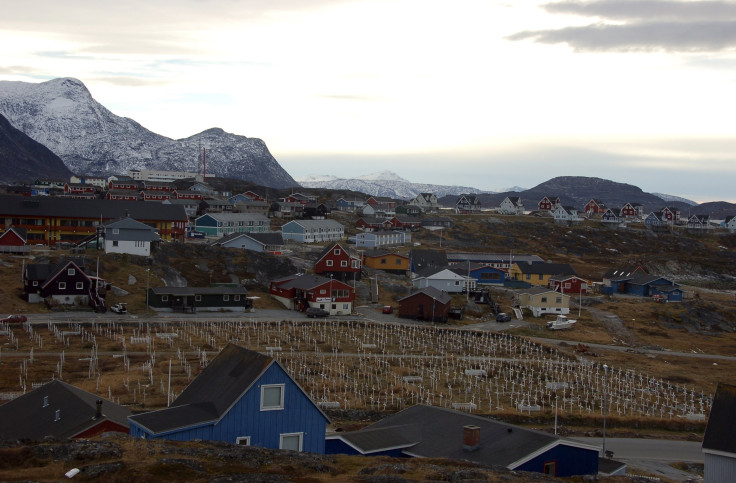Suicide Is Painful: Greenland’s Bleak Landscape, Poverty, Alcoholism, Lengthy Seasons, Culture Clash Conspire To Trigger High Rates Of Self-Killing

Most people do not like to think about a subject as disturbing and distressing as suicide. Most people also rarely think about the giant Arctic island nation of Greenland.
Yes, these two seemingly unrelated things are linked – Greenland has one of the world’s highest rates of people killing themselves.
Slate magazine reports that Greenland has a suicide rate of some 100 per 100,000 inhabitants. Of course, Greenland doesn’t even have 100,000 people; the sparsely populated Arctic wilderness boasts a population of less than 60,000. However, on a per capita basis, Greenlanders do away with themselves at double the rate of Japan, a country where suicide is virtually installed in their culture and DNA.
The problem is particularly acute among teenagers and young adults (in contrast to most other nations where the middle-aged and elderly dominate the self-inflicted death tolls). More than half of all suicides in Greenland comprise young men; while one-quarter of young females have confessed to having attempted to kill themselves.
"Every young person in Greenland knows someone who has committed suicide," Bodil Karlshøj Poulsen, director of Paarisa, Greenland’s public-health center, told Slate. "It's a new phenomenon."
Indeed, Greenland, an ancient land where for 4,000 years the people engaged in a simple lifestyle of fishing and hunting in their tight-knit villages, suicides were extremely rare.
But by 1953 Greenland joined the outside world by becoming a part of Denmark, thereby initiating a process of modernization that included a transformation of traditional culture – part of the policy included moving thousands of the indigenous Inuit people from their villages into Soviet-style apartment complexes.
Slate notes that something drastic changed Greenlander culture around 1970, when suicides began to climb, especially among the young – who tragically did not have a mental health support systems to aid in their struggles.
Inger Bordbar, a nurse and suicide prevention consultant, spoke to Al-Jazeera about the depressed teens she works with in Greenland.
"It's difficult to verbalize how they feel, they find it hard to explain why they are sad, or angry,” she said. “They keep it inside them and carry it around for a long time. That's one of the explanations for the suicide. But also, that they aren't being offered therapy or psychological help. For a long time we didn't have psychologists and therapists. Those professionals dealing with it do what they can to help the children; they do a huge amount of work."
The proliferation of guns and rifles – used for hunting oxen and caribou – makes suicide an easy and accessible alternative for many Greenlanders.
"Young people in Norway and Sweden make a lot of suicide attempts with pills, but they're not successful. Here [in Greenland] the kids are successful because it's always so violent," added Poulsen.
Why does this remote, isolated and wintry land have such a high rate of suicide? Part of the reason may have to do with poverty, alcoholism and incidence of incest – but these same conditions exist in many other northern climes.
Poulsen asserts that it’s a dreary mystery.
"If I knew, I would tell you,” she noted. “We just don't know."
Despite recent government-run awareness campaigns and suicide prevention hotlines, Greenland is averaging about one suicide per week.
Peter Bjerregaard, a Greenland native who works at the National Institute of Public Health in Copenhagen, told Vice.com: “It’s very difficult to explain why suicide attempts are so frequent among youths in Greenland. The schools aren’t always up to standards. A high proportion of their parents are unemployed or they have problems with alcohol. And a lot of kids have been molested.”
Another problem may be mass communications and the Internet – Greenlander youth now can view how their peers in other countries live, something most of them can’t hope to aspire to.
“The problem isn’t the kids, it’s the society and the mismatch between the actual living conditions and the life they wished they had,” Bjerregaard added.
Strangely, the long dark winter Greenland endures is probably not to blame – most suicides occur in the summer, peaking in June.
Science News speculated that the summer sun may actually be a culprit behind some of the carnage – that is, the excessive hours of daylight during the season leads to insomnia, disrupting sleeping cycles and schedules. In the northernmost regions of Greenland, the sun does not set between April and August.
Karin Sparring Björkstén, a researcher at the Karolinska Institutet in Sweden, told Science News: "In terms of seasonal light variation, Greenland is the most extreme human habitat. … We found that suicides … increased during periods of constant day. In the north of the country, 82 percent of the suicides occurred during the daylight months.”
Thus, a lack of sleep, plus imbalances in serotonin levels, may partially account for suicidal impulses.
"People living at high latitudes need extreme flexibility in light adaptation,” the Karolinska researchers stated.
“During the long periods of constant light, it is crucial to keep some circadian rhythm to get enough sleep and sustain mental health. A weak serotonin system may cause difficulties in adaptation."
Yet, other nations in the Arctic zone endure similar night-less summers – Greenland seems to be caught in a vortex of a unique constellation of factors that contribute to extremely high rates of suicide.
A young Greenlander female named Sara, who has lost many of her friends to suicide, told Vice.com: “It’s so selfish to commit suicide, so easy, and I think it has a lot to do with loneliness and isolation. You don’t have any ambitions. You have no money, and Greenland can be really difficult to leave. It’s almost like a tiny prison. For some, suicide is the only way to get out.”
© Copyright IBTimes 2024. All rights reserved.





















